Spatial Distribution Pattern and Evolution Characteristics of Elderly Population in Wuhan Based on Census Data
Abstract
:1. Introduction
2. Materials and Methods
2.1. Research Subject
2.2. Data Sources
2.3. Research Methods
2.3.1. Detection of Aging Spatial Hotspots Based on Kernel Density
2.3.2. Analysis of the Aggregation Degree of Elderly Population Based on Global and Local Spatial Autocorrelation
2.3.3. Analysis of Spatial Centroid Shift Trend of Elderly Population Based on Standard Deviation Ellipse
3. Results
3.1. Spatial Distribution Patterns and Evolution Characteristics of Elderly Population in Wuhan City at the Street Scale
3.2. The Distribution Trend and Clustering Characteristics of Spatial Elderly Population Density in Various Streets in Wuhan City
3.2.1. Spatial Detection of Hotspots in the Elderly Population
3.2.2. Spatial Clustering Characteristics of the Elderly Population
3.3. The Spatial Distribution Pattern and Evolutionary Trend of the Elderly Population Scale across Various Streets in Wuhan City
3.3.1. Measurement of Spatial Center of Gravity of Elderly Population in Wuhan
3.3.2. The Overall Spatial Distribution and Evolutionary Trend of Population in Wuhan
4. Discussion
4.1. Testing the Rationality of the Spatial Distribution Pattern and Evolution Characteristics of Population Aging at the Mesoscale
4.2. The Necessity of Multiple Indicators for Examining the Spatial Patterns of Population Aging
5. Conclusions
Author Contributions
Funding
Data Availability Statement
Conflicts of Interest
| 1 | “Street/Township” is a shortened term for the management unit of either a Street Office or Township Government. The two are of the same administrative level, but differ in that Street Offices are located within the main urban area of a city, while Township Governments are located in more distant suburban areas. |
| 2 | According to the classification standards of aging by the United Nations, if the proportion of the population aged 65 and over exceeds 7%, this indicates a mildly aging society; if the proportion of population aged 65 and over exceeds 14%, this indicates a moderately aging society; if the proportion of population aged 65 and over exceeds 20%, this indicates a severely aging society. |
References
- Lu, J.; Gu, Y. The Real Connotation, Core Issues and Practical Paths of Optimizing China’s Population Development Strategy. J. Soc. Sci. 2023, 1–12. Available online: http://kns.cnki.net/kcms/detail/21.1012.C.20230601.1328.004.html (accessed on 6 May 2023).
- China’s Medium and Long Term Plan for Actively Responding to Population Aging. Available online: http://www.gov.cn/zhengce/2019-11/21/content_5454347.htm (accessed on 2 March 2023).
- Zhao, Q. Actively addressing the issue of population aging. China Soc. Sci. J. 2023. [Google Scholar] [CrossRef]
- Liu, W. Multi subject protection: Digital enabling smart pension model. J. Shenyang Inst. Eng. 2022, 18, 18–23+35. [Google Scholar] [CrossRef]
- Chen, X.; Song, W.; Jin, Y. Research on the Current Situation, Impact, and Countermeasures of Population Aging Development in Hubei Province: Statistical Analysis Based on the Seventh National Population Census Data. Hubei Soc. Sci. 2022, 423, 59–69. [Google Scholar] [CrossRef]
- Zhou, J. Spatial Distribution Characteristics and Evolution Trend of Urban Aging Population. Urban Plan. 2014, 38, 18–25. [Google Scholar] [CrossRef]
- Yu, J.; Rosenberg, M.W. Aging and the changing urban environment: The relationship between older people and the living environment in post-reform Beijing, China. Urban Geogr. 2020, 41, 162–181. [Google Scholar] [CrossRef] [Green Version]
- Xu, X.; Zhao, Y.; Zhang, X.; Zhang, X. Spatial differentiation and evolution of population aging in Jiangsu Province and its influencing factors. Geogr. Sci. 2017, 37, 1859–1866. [Google Scholar] [CrossRef]
- Yi, C.; Zhang, C.; Wu, S.; Gao, M.; Liang, H. Research on the Spatial Distribution and Changes of the Elderly Population in Beijing from 2000 to 2010. Urban Dev. Res. 2014, 21, 66–71. [Google Scholar] [CrossRef]
- Zhang, K.; Sun, H.; Li, X. Aging Population Spatial Distribution Discrepancy and Impacting Factor. Sustainability 2022, 14, 9528. [Google Scholar] [CrossRef]
- Lewandowska-Gwarda, K.; Antczak, E. Urban Ageing in Europe—Spatiotemporal Analysis of Determinants. ISPRS Int. J. Geo-Inf. 2020, 9, 413. [Google Scholar] [CrossRef]
- Wang, Z.; Hu, C.; Yan, H.; Qiu, L. The spatial-temporal evolution characteristics and spatial guidance strategy of China’s municipal population—Based on the population data of 317 Prefecture-level city for “five popular”, “six popular” and “seven popular”. Planner 2022, 38, 14–20. [Google Scholar] [CrossRef]
- Xie, B.; Zhou, J. A Study on the Spatial Distribution Pattern and Development Trends of Elderly People in Large Cities: Taking Beijing, Shanghai, Guangzhou, and Wuhan as Examples. J. Urban Plan. 2013, 5, 56–62. [Google Scholar] [CrossRef]
- Wang, J.; Shao, Y. A Study on the Spatial Distribution and Evolution of the Elderly Population in Hangzhou. Urban Plan. 2015, 39, 47–51. [Google Scholar] [CrossRef]
- Li, T. The spatial distribution and influencing factors of the aging population in Shanghai. Urban Plannin. 2020, 44, 39–46. [Google Scholar]
- Ren, Y. A Study on the Spatial Aggregation Characteristics and Evolutionary Trends of the Elderly Population in Beijing: An Empirical Study Based on the Data of the Fifth and Sixth Population Censuses. Urban Dev. Res. 2017, 24, 5–8. [Google Scholar] [CrossRef]
- Zheng, Y. Analysis of Spatial Differences in China’s Population Aging Based on Multiscale. Master’s Thesis, Zhejiang University, Hangzhou, China, 2015. [Google Scholar]
- Lin, X.; Wang, D.; Wang, N.; Ren, Y. The spatial distribution pattern characteristics and driving forces of the elderly population in Beijing. Reg. Res. Dev. 2016, 35, 158–164. [Google Scholar]
- Liu, Y.; Huang, Y.; Lai, M.; Gong, H. Research on the Spatial Structure and Evolutionary Trends of Urban Population in Guangzhou. Popul. Dev. 2023, 29, 41–50. [Google Scholar]
- Liang, H. Exploring the Method of Measuring Spatial Differences in Population Age Structure: Analysis Based on the Data of the Fifth and Sixth Population Censuses in Beijing. Popul. Soc. 2018, 34, 32–40. [Google Scholar]
- Zhang, T. Research on the Spatial Distribution and Development Trend Prediction of the Aged Population in Wuhan. Master’s Thesis, Zhongnan University of Economics and Law, Wuhan, China, 2017. [Google Scholar]
- Zhang, C.; Cao, G. Spatial characteristics and influencing factors of population aging in Beijing. Urban Dev. Res. 2007, 2, 56–61. [Google Scholar] [CrossRef]
- Ling, Y.; Kai, Z.; Zhen, F. Exploring Determinants of Population Aging in Northeast China: From a Social Economic Perspective. Int. J. Environ. Res. Public Health. 2019, 16, 4265. [Google Scholar] [CrossRef] [Green Version]
- Shiode, N.; Morita, M.; Shiode, S.; Okunuki, K.I. Urban and rural geography of aging: A local spatial correlation analysis of aging population measures. Urban Geogr. 2014, 35, 608–628. [Google Scholar] [CrossRef]
- Atkins, M.T.; Tonts, M. Exploring Cities through a Population Aging Matrix: A spatial and temporary analysis of older adult population trends in Perth, Australia. Aust. Geogr. 2016, 47, 65–87. [Google Scholar] [CrossRef]
- Wei, S.; Wang, Y.; Xu, C.; Wang, L. Identification of the elderly population recognition based on mobile signaling data. Shandong Transp. Technol. 2022, 2, 131–134+147. [Google Scholar] [CrossRef]
- Jiang, J.; Chen, M.; Zhang, J. Research on the differences and influencing factors of elderly tourists’ activities in Shanghai community parks. Landsc. Des. 2020, 8, 94–109. [Google Scholar] [CrossRef]
- Li, L.; Yang, S.; Zhang, C.; Han, L. Research on the Location of Elderly Care Service Facilities Based on Mobile Phone Signaling Data—Taking Chengdu as an Example. Sichuan Archit. 2020, 40, 4–6. [Google Scholar]
- Wang, Q.; Zhao, H.; Wan, J. Research on the Characteristics of Occupation and Residence in Main Urban Areas of Wuhan Supported by Big data of Yichou. Surv. Mapp. Bull. 2023, 3, 144–149. [Google Scholar] [CrossRef]
- Guan, W.; Wu, Z.; Wu, Z.; Cao, Z.; Liu, X. Spatial and temporal detection of urban population activity and analysis of its influencing factors based on WeChat travel data. Mod. Urban Res. 2021, 2–9. [Google Scholar] [CrossRef]
- Wang, C.; Xu, W.; Ding, Y. Research on the service level of parks and squares in the central urban area of Nanjing based on cycling index. Geogr. Geogr. Inf. Sci. 2021, 37, 53–58. [Google Scholar] [CrossRef]
- Duan, Y.; Liu, Y.; Liu, X.; He, D. Multi center spatial structure analysis based on the Big data of Yixing—Taking the main urban area of Chongqing as an example. Prog. Geogr. Sci. 2019, 38, 1957–1967. [Google Scholar] [CrossRef]
- Xu, Z.; Lin, X.; Luo, C. Research on spatial-temporal evolution and spatial type of population aging in Chongqing. J. Beijing Norm. Univ. (Nat. Sci. Ed.) 2019, 55, 772–779. [Google Scholar] [CrossRef]
- Ma, X.; Zhang, W.; Xue, H.; Li, K. Analysis of the spatial distribution and evolution characteristics of population aging in Gansu Province. Northwest Popul. 2014, 35, 115–121. [Google Scholar] [CrossRef]
- Hu, J.; Zhao, G. Research on the Spatial Distribution Evolution of the Elderly Population in Guangdong Province from 2000 to 2010. Northwest Popul. 2014, 35, 30–35. [Google Scholar] [CrossRef]
- Man, W.; Wang, S.; Yang, H. Exploring the spatial temporal distribution and evolution of population aging and social economic indicators in China. BMC Public Health 2021, 21, 966. [Google Scholar] [CrossRef] [PubMed]
- Yang, H.J. Visualizing spatial divisions in population aging in the Seven Metropolitan Area. Environ. Plan. A Econ. Space 2021, 53. [Google Scholar] [CrossRef]
- Fan, G.; Shao, J. Spatial and temporal evolution of population aging in China in the past 20 years and its driving mechanism. J. Nanyang Norm. Univ. 2021, 20, 1–8+27. [Google Scholar] [CrossRef]
- Zeng, T.; Zhao, Y.; Xu, X. Research on the evolution of spatial pattern of aging population in China and its influencing factors. Geogr. Geogr. Inf. Sci. 2017, 33, 72–79. [Google Scholar] [CrossRef]
- Lin, L.; Ma, F. Spatial distribution and trend of population aging in Guangzhou. Geogr. Res. 2007, 1043–1054. [Google Scholar] [CrossRef]
- Vemulapalli, S.S.; Ulak, M.B.; Ozguven, E.E.; Sando, T.; Horner, M.W.; Abdelrazig, Y.; Moses, R. GIS-based Spatial and Temporal Analysis of Aging-Involved Accidents: A Case Study of Three Counties in Florida. Appl. Spat. Anal. Policy. 2017, 10, 537–563. [Google Scholar] [CrossRef]
- Wu, L.; Huang, Z.; Pan, Z. The spatiality and driving forces of population ageing in China. PLoS ONE 2021, 16, e0243559. [Google Scholar] [CrossRef]
- Hinrichs, T.; Zanda, A.; Fillekes, M.P.; Bereuter, P.; Portegijs, E.; Rantanen, T.; Schmidt-Trucksäss, A.; Zeller, A.W.; Weibel, R. Map-based assessment of older adults’ life space: Validity and reliability. Eur. Rev. Aging Phys. Act. 2020, 17, 21. [Google Scholar] [CrossRef]
- Niu, Q.; Sheng, J.; Liu, X.; Yan, X. The spatial heterogeneity impact of commercial and public service facilities on residents’ relocation in Wuhan. Geogr. Sci. 2023, 43, 860–868. [Google Scholar] [CrossRef]
- Ma, L.; Zhang, Z. Spatial distribution and formation mechanism of the elderly population in Lanzhou City. Hum. Geogr. 2015, 30, 132–137. [Google Scholar] [CrossRef]
- Ning, Y.; Zhao, X.; Li, X.; Shi, D.; Deng, L.; He, T. Research on Demographics of Shanghai Population Development Trend and Countermeasures. Shanghai Urban Plan. 2011, 16–26. [Google Scholar] [CrossRef]
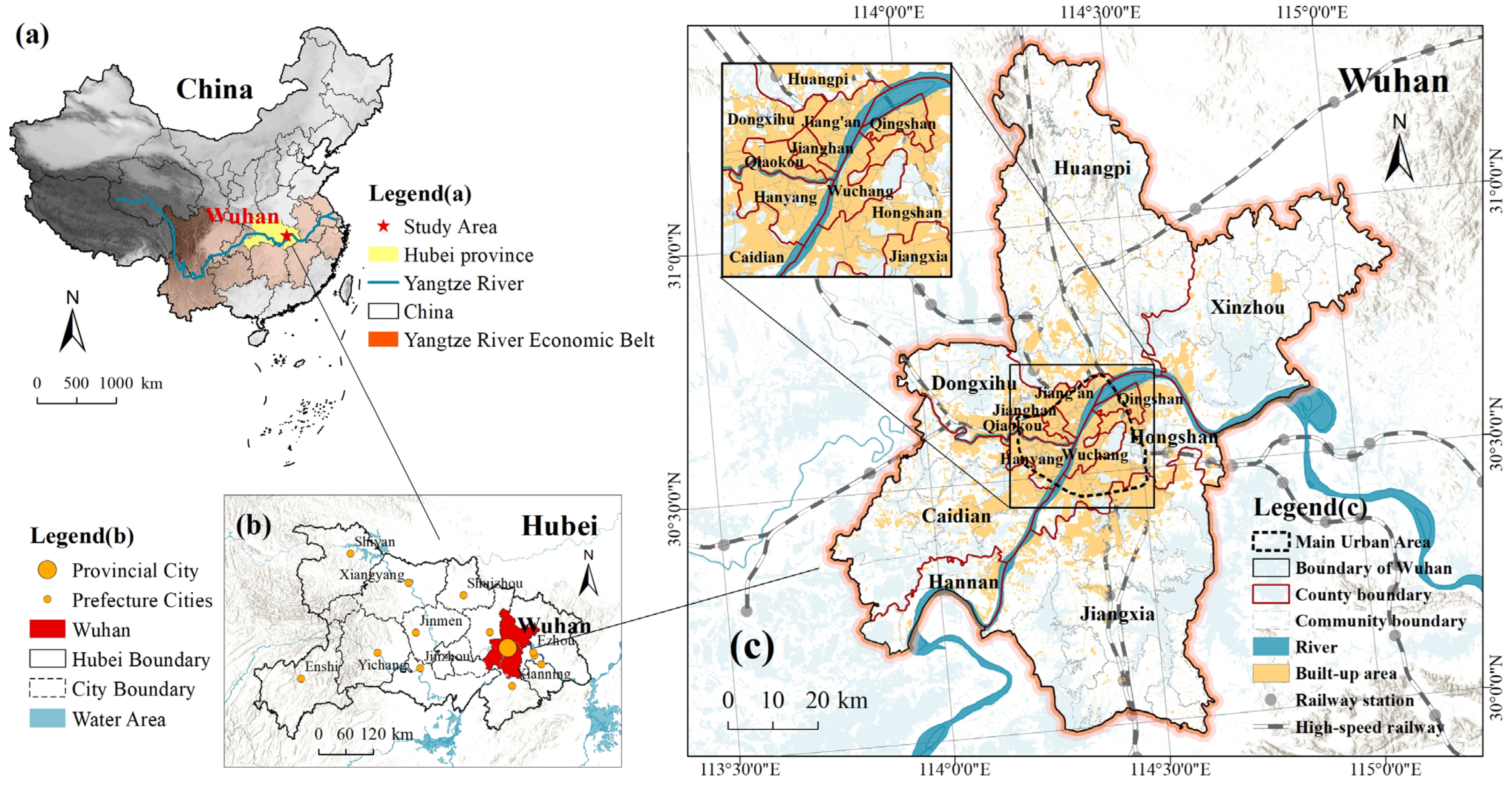


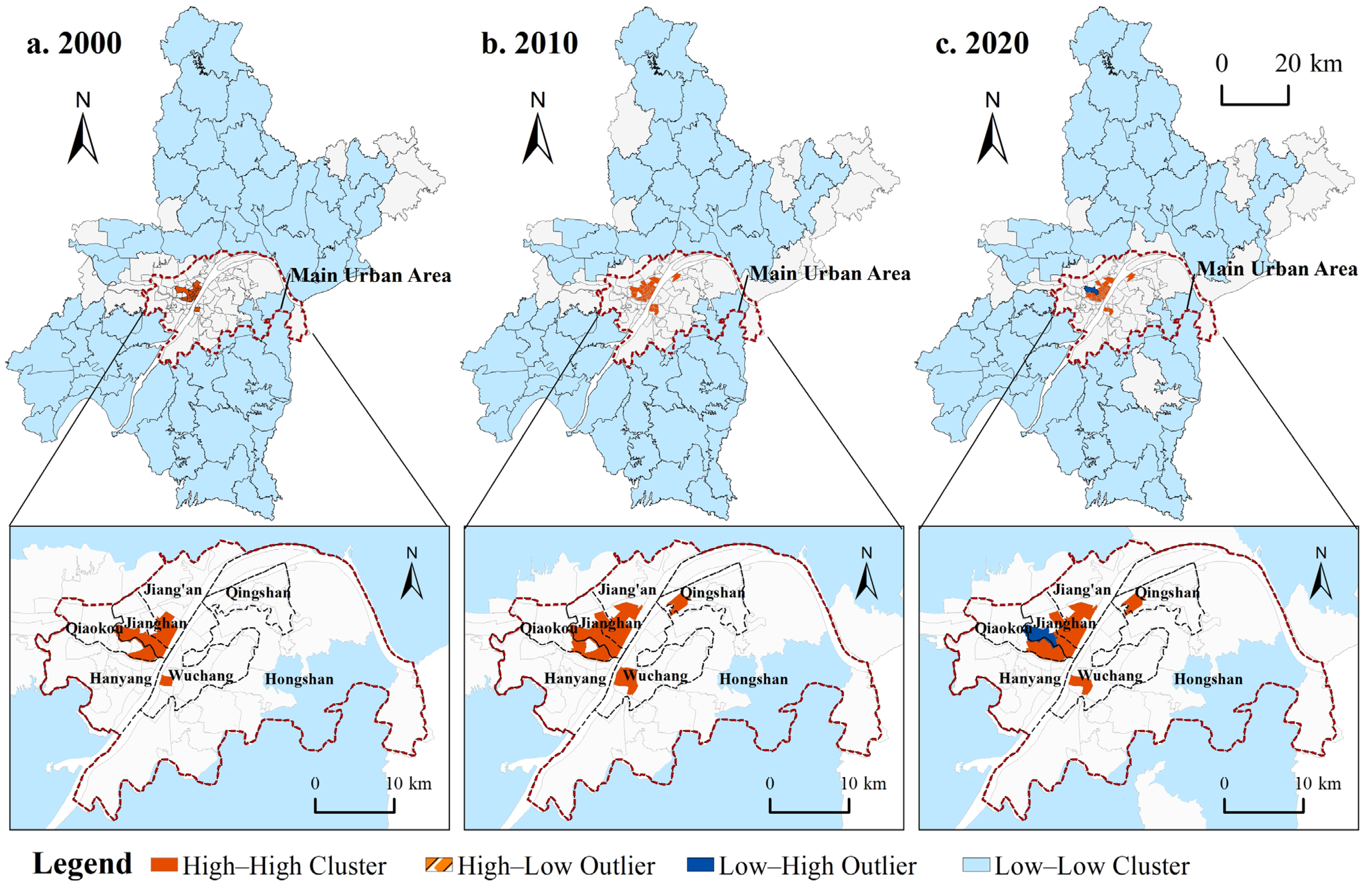

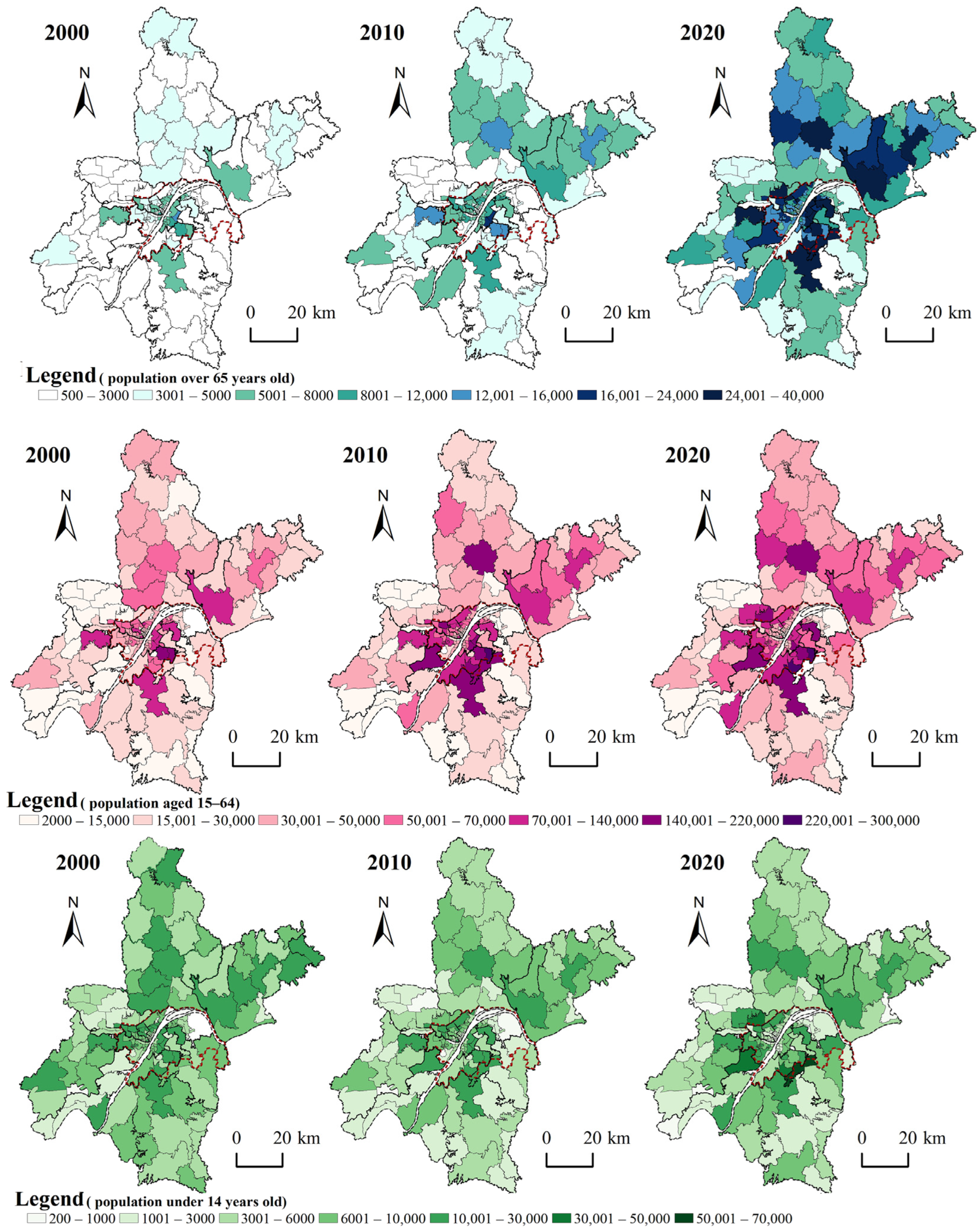
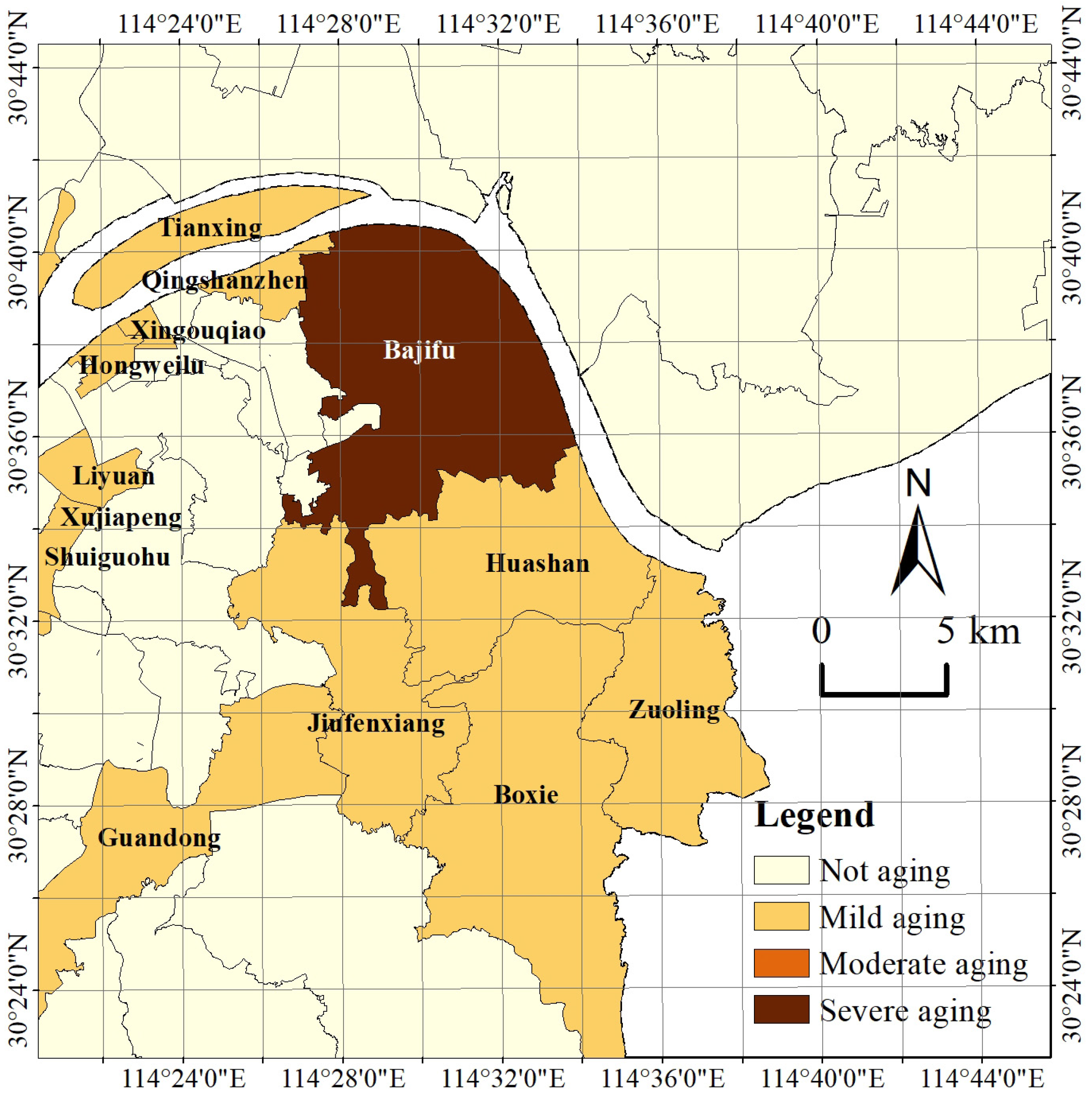
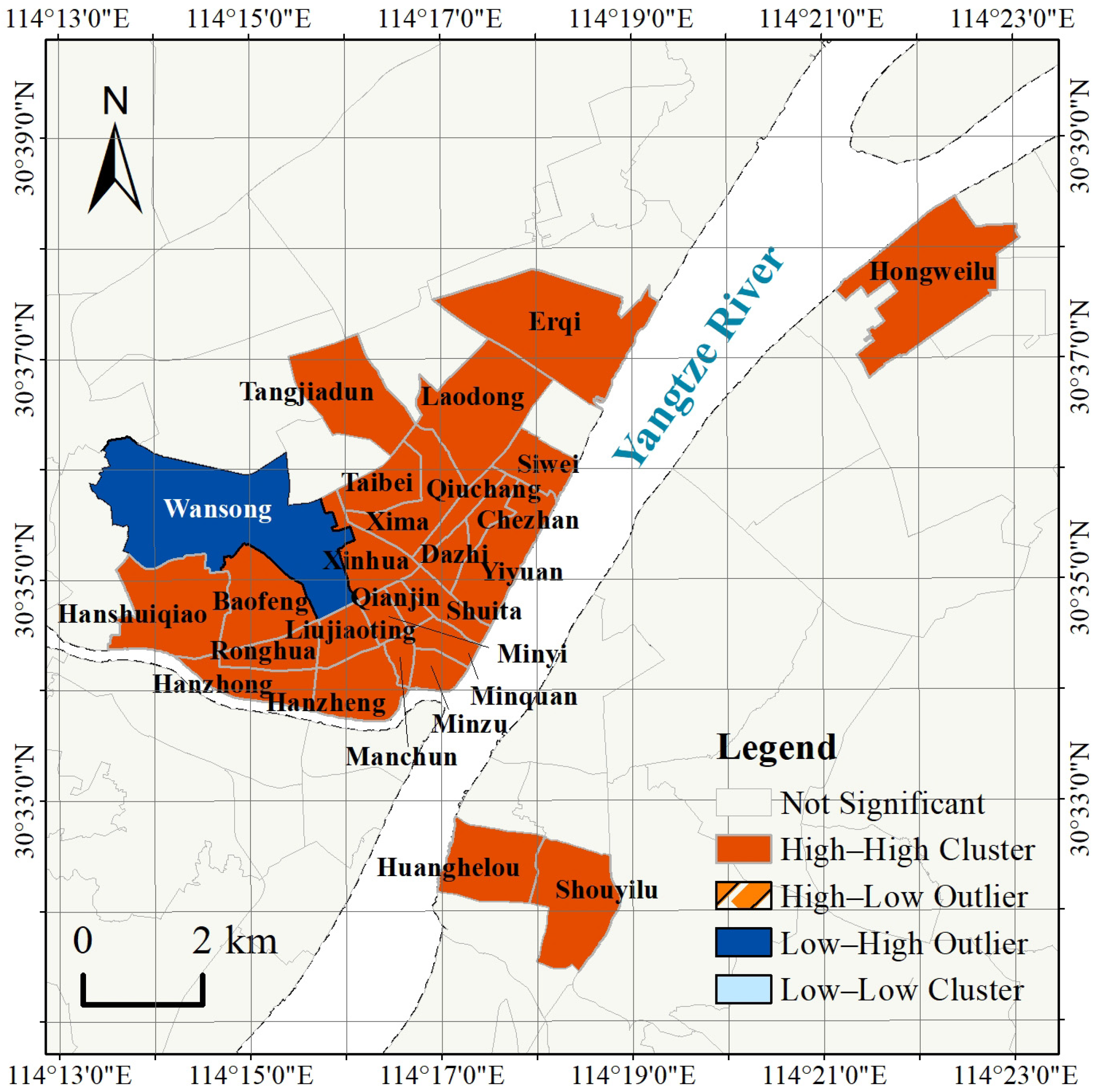
| Year | Not Aging (PA ≤ 7) | Mild Aging (7 < PA ≤ 14) | Moderate Aging (14 < PA ≤ 20) | Severe Aging (PA > 20) |
|---|---|---|---|---|
| 2000 | 78 | 77 | 0 | 1 |
| 2010 | 30 | 122 | 3 | 1 |
| 2020 | 3 | 28 | 69 | 56 |
| Year | Moran‘s I | Z-Test Value | p-Value |
|---|---|---|---|
| 2000 | 0.833 | 16.763 | <0.001 |
| 2010 | 0.745 | 14.909 | <0.001 |
| 2020 | 0.706 | 14.140 | <0.001 |
| Year | Central Longitude (°E) | Central Latitude (°N) | Short Semi-Axis (km) | Long Semi-Axis (km) | Azimuth (°) |
|---|---|---|---|---|---|
| 2000 | 114.314 | 30.607 | 19.28 | 29.08 | 38.07 |
| 2010 | 114.323 | 30.618 | 20.20 | 31.81 | 38.90 |
| 2020 | 114.325 | 30.614 | 19.69 | 30.68 | 39.94 |
| 2000 (10,000 People) | 2010 (10,000 People) | 2020 (10,000 People) | |
|---|---|---|---|
| aged 65 and over | 56.96 | 79.51 | 145.62 |
| aged 15–64 | 622.57 | 801.33 | 926.22 |
| aged 0–14 | 151.74 | 97.70 | 160.81 |
| total population | 831.27 | 978.54 | 1232.65 |
Disclaimer/Publisher’s Note: The statements, opinions and data contained in all publications are solely those of the individual author(s) and contributor(s) and not of MDPI and/or the editor(s). MDPI and/or the editor(s) disclaim responsibility for any injury to people or property resulting from any ideas, methods, instructions or products referred to in the content. |
© 2023 by the authors. Licensee MDPI, Basel, Switzerland. This article is an open access article distributed under the terms and conditions of the Creative Commons Attribution (CC BY) license (https://creativecommons.org/licenses/by/4.0/).
Share and Cite
Li, F.; Zhou, J.; Wei, W.; Yin, L. Spatial Distribution Pattern and Evolution Characteristics of Elderly Population in Wuhan Based on Census Data. Land 2023, 12, 1350. https://doi.org/10.3390/land12071350
Li F, Zhou J, Wei W, Yin L. Spatial Distribution Pattern and Evolution Characteristics of Elderly Population in Wuhan Based on Census Data. Land. 2023; 12(7):1350. https://doi.org/10.3390/land12071350
Chicago/Turabian StyleLi, Fan, Jie Zhou, Wei Wei, and Li Yin. 2023. "Spatial Distribution Pattern and Evolution Characteristics of Elderly Population in Wuhan Based on Census Data" Land 12, no. 7: 1350. https://doi.org/10.3390/land12071350





